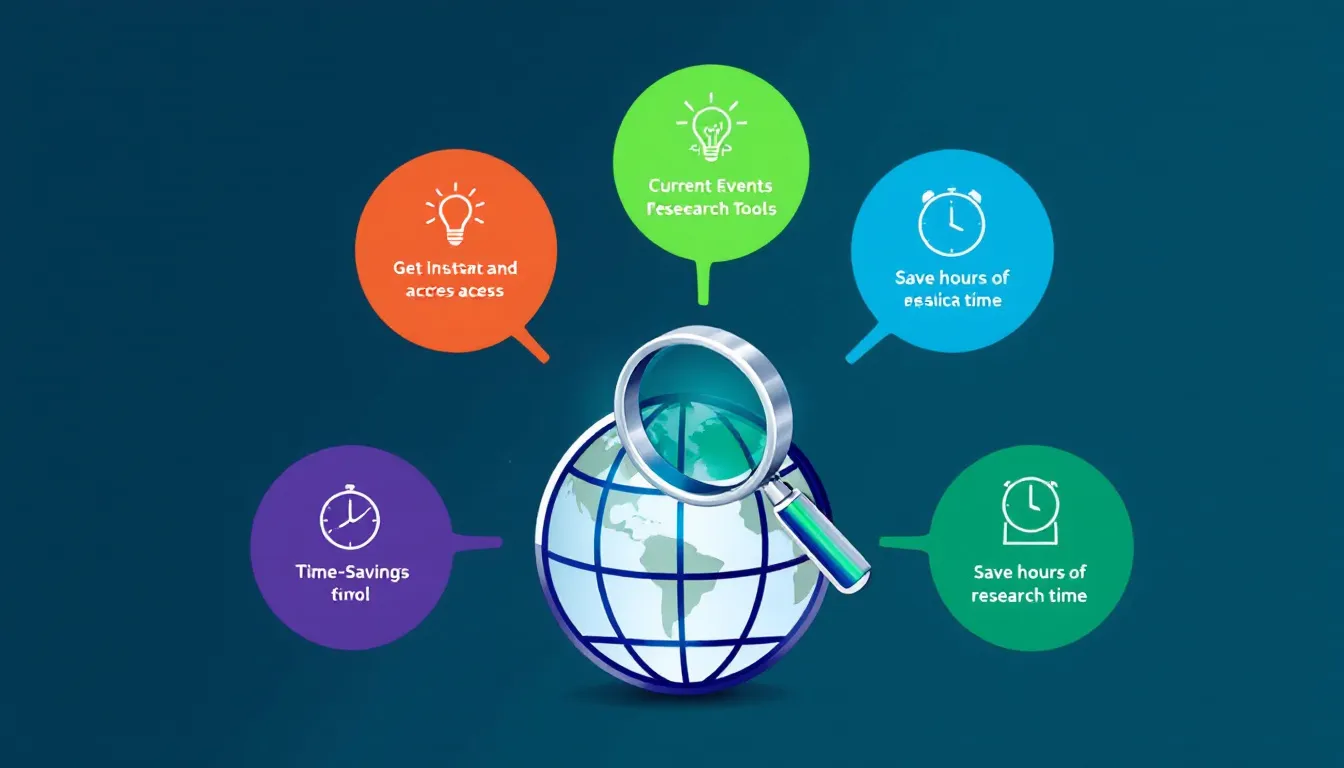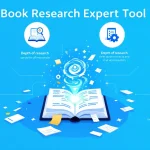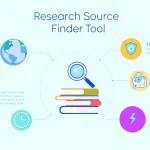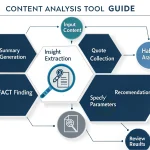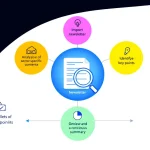Is this tool helpful?
How to Use the Current Events and Trends Research Tool Effectively
Our Current Events and Trends Research Tool is designed to streamline the process of gathering and analyzing information on the latest developments in your chosen field. Here’s a step-by-step guide on how to use this tool effectively:
1. Specify the Field or Topic
In the first input field, enter the specific field or topic you want to research. This could be a broad area or a more focused subject. For example:
- Renewable Energy Technologies
- Digital Marketing Strategies
2. Define the Time Frame (Optional)
If you want to focus on a particular period, enter it in the second field. This helps narrow down the research to the most relevant timeframe. Examples include:
- Past six months
- Last two years
3. Specify Aspects or Subtopics (Optional)
Use the textarea to list any specific aspects or subtopics within your chosen field that you want to focus on. This allows for a more targeted research approach. For instance:
- For Renewable Energy Technologies: Solar panel efficiency improvements, offshore wind farm developments
- For Digital Marketing Strategies: Influencer marketing trends, AI-driven personalization techniques
4. Submit and Review Results
Click the “Research Current Events and Trends” button to initiate the research process. The tool will compile and analyze information from various credible sources, presenting a comprehensive report on the latest developments, emerging trends, and key players in your specified field.
5. Utilize the Research Findings
Review the generated report carefully. You can copy the entire content to your clipboard using the “Copy to Clipboard” button for easy sharing or further analysis.
Introduction to the Current Events and Trends Research Tool
In today’s fast-paced world, staying informed about the latest developments in any field is crucial for professionals, researchers, and decision-makers. Our Current Events and Trends Research Tool is designed to meet this need by providing a comprehensive, up-to-date analysis of the most recent events, emerging trends, and influential figures in your area of interest.
This innovative tool leverages advanced algorithms and access to a wide range of credible sources to deliver accurate, relevant, and timely information. By simulating the work of a seasoned journalist, it gathers data from news outlets, academic journals, expert interviews, and industry reports, ensuring a well-rounded and unbiased perspective on your chosen topic.
Purpose and Benefits
The primary purpose of this tool is to save time and effort in the research process while providing high-quality, actionable insights. Some key benefits include:
- Rapid access to the most recent developments in your field
- Identification of emerging trends and patterns
- Comprehensive overview of key players and influencers
- Time-saving alternative to manual research
- Unbiased and ethically sourced information
Benefits of Using the Current Events and Trends Research Tool
1. Time Efficiency
One of the most significant advantages of using this tool is the time saved in the research process. What might take hours or even days of manual searching and analysis can be accomplished in minutes. This efficiency allows professionals to focus more on interpreting and applying the information rather than spending excessive time gathering it.
2. Comprehensive Coverage
The tool accesses a wide range of sources, ensuring that no crucial information is missed. This comprehensive approach provides a more complete picture of the current state and future direction of your chosen field, helping you make more informed decisions.
3. Unbiased Reporting
By adhering to journalistic standards of ethics and integrity, the tool provides unbiased information. This objectivity is crucial for forming accurate opinions and making sound decisions based on facts rather than potentially skewed perspectives.
4. Identification of Emerging Trends
The tool’s ability to analyze large amounts of data allows it to identify patterns and emerging trends that might not be immediately apparent through manual research. This feature is particularly valuable for professionals looking to stay ahead of the curve in their industries.
5. Customizable Focus
The option to specify particular aspects or subtopics within a field allows for highly targeted research. This customization ensures that the information provided is directly relevant to your specific interests or needs.
6. Regular Updates
Unlike static reports or outdated publications, this tool provides up-to-date information, ensuring that you’re always working with the most current data available.
7. Enhanced Decision Making
Access to comprehensive, current, and unbiased information empowers users to make more informed decisions. Whether you’re a business leader, researcher, or policy maker, having a clear understanding of the latest developments in your field is crucial for strategic planning and decision-making.
Addressing User Needs and Solving Specific Problems
The Current Events and Trends Research Tool is designed to address several common challenges faced by professionals, researchers, and decision-makers across various industries:
1. Information Overload
In the digital age, the sheer volume of information available can be overwhelming. This tool solves this problem by filtering and distilling vast amounts of data into concise, relevant reports. For example, if a marketing professional wants to understand the latest trends in social media advertising, instead of sifting through countless articles and reports, they can use this tool to get a comprehensive overview quickly.
2. Time Constraints
Many professionals struggle to find time for thorough research amidst their busy schedules. This tool addresses this issue by automating the research process, delivering results in minutes rather than hours or days. A business consultant preparing for a client meeting on sustainable business practices can use the tool to gather the most recent information without spending days on research.
3. Bias and Misinformation
In an era of fake news and biased reporting, finding objective information can be challenging. The tool’s adherence to journalistic standards ensures that the information provided is as unbiased and accurate as possible. For instance, a policy advisor researching climate change policies can rely on this tool to provide a balanced view of current debates and scientific findings.
4. Identifying Emerging Trends
Staying ahead of industry trends is crucial for many professionals. This tool excels at identifying emerging patterns and developments that might not be immediately apparent. An investor looking to understand the future of electric vehicles could use this tool to identify upcoming technologies or market shifts that could influence investment decisions.
5. Cross-Industry Insights
Many innovations occur at the intersection of different fields. This tool can help users identify cross-industry trends and potential applications. For example, a healthcare professional interested in the application of artificial intelligence in medicine can use the tool to gather insights not just from the medical field but also from AI research and technology sectors.
6. Academic Research Support
For researchers and academics, staying current with the latest publications and developments in their field is essential. This tool can provide a comprehensive overview of recent studies, conference proceedings, and academic discussions, saving valuable time in literature reviews.
Practical Applications and Use Cases
The Current Events and Trends Research Tool has a wide range of practical applications across various sectors. Here are some illustrative examples:
1. Business Strategy Development
A multinational corporation is planning to expand its operations into emerging markets. The strategy team uses the tool to research current economic trends, regulatory environments, and market dynamics in potential target countries. By inputting “Emerging Market Business Opportunities” as the field and specifying subtopics like “Regulatory Changes” and “Consumer Behavior Trends,” they receive a comprehensive report that informs their expansion strategy.
2. Academic Research
A doctoral student in environmental science is beginning their dissertation on the impact of microplastics on marine ecosystems. They use the tool to gather the most recent studies, policy discussions, and technological developments in this area. By specifying “Microplastics in Marine Ecosystems” as the field and “Recent Scientific Findings” and “Policy Initiatives” as subtopics, they quickly compile a current literature review that forms the foundation of their research.
3. Journalism and Media
A news organization is preparing a special report on the future of work post-pandemic. The editorial team uses the tool to research global trends in remote work, changes in office design, and emerging technologies shaping the workplace. They input “Future of Work” as the main field and specify subtopics like “Remote Work Trends” and “Workplace Technology Innovations.” The resulting report provides a solid foundation for their investigative journalism.
4. Investment Analysis
An investment firm is considering entering the renewable energy sector. They use the tool to analyze current trends, technological advancements, and policy changes affecting the industry. By researching “Renewable Energy Investment Opportunities” and focusing on subtopics like “Solar Technology Advancements” and “Government Incentives,” they gain valuable insights to inform their investment decisions.
5. Policy Development
A think tank is advising on urban development policies. They use the tool to research global best practices in smart city initiatives, sustainable urban planning, and public transportation innovations. By specifying “Smart City Development” as the main field and “Sustainable Urban Planning” and “Public Transportation Innovations” as subtopics, they gather comprehensive data to support their policy recommendations.
6. Healthcare Innovation
A healthcare technology startup is developing a new telemedicine platform. They use the tool to research the latest trends in digital health, patient data security, and regulatory changes affecting telemedicine. By inputting “Telemedicine Advancements” as the main field and specifying “Patient Data Security” and “Telemedicine Regulations” as subtopics, they gather crucial information to guide their product development and ensure compliance.
FAQ Section
Q1: How often is the information updated?
A1: The tool accesses real-time data sources, ensuring that the information provided is as current as possible. Each time you use the tool, it performs a fresh search and analysis based on the most recent available data.
Q2: Can I save or export the research results?
A2: Yes, you can easily copy the entire research report to your clipboard using the “Copy to Clipboard” button provided. From there, you can paste the information into any document or application of your choice for further analysis or sharing.
Q3: Is the tool suitable for academic research?
A3: Absolutely. The tool accesses a wide range of credible sources, including academic journals and expert interviews, making it a valuable resource for academic research. However, it’s important to note that while the tool provides an excellent starting point and overview, it should be used in conjunction with traditional academic research methods for comprehensive scholarly work.
Q4: Can I use the tool for multiple research topics simultaneously?
A4: The tool is designed to focus on one research topic at a time to ensure the most relevant and focused results. However, you can run multiple searches consecutively for different topics or aspects of your research.
Q5: How does the tool determine the credibility of its sources?
A5: The tool is programmed to prioritize well-established, reputable sources such as recognized news outlets, peer-reviewed academic journals, and industry-leading publications. It also cross-references information from multiple sources to ensure accuracy and reliability.
Q6: Can I specify a particular geographical focus for my research?
A6: Yes, you can include geographical specifications in the “Specific Focus” field. For example, if you’re researching renewable energy trends in Europe, you can mention this in the specific focus area to ensure the tool prioritizes information relevant to that region.
Q7: How detailed are the research reports?
A7: The level of detail in the reports can vary depending on the specificity of your input and the availability of information. Generally, the tool provides a comprehensive overview of key trends, recent developments, and significant players in your specified field. For more in-depth analysis on specific aspects, you may need to conduct follow-up research using the insights provided.
Q8: Is the tool suitable for non-English language research?
A8: Currently, the tool primarily focuses on English-language sources. However, it may include some information from non-English sources that have been translated or reported in English-language media.
Q9: How does the tool handle conflicting information from different sources?
A9: When conflicting information is encountered, the tool attempts to present a balanced view by including multiple perspectives. It may highlight areas of consensus as well as points of contention, allowing users to understand the full scope of debates or disagreements within a field.
Q10: Can the tool predict future trends?
A10: While the tool is excellent at identifying current trends and recent developments, it does not make explicit predictions about the future. However, by analyzing emerging patterns and expert opinions, it can provide insights that may be indicative of future directions in a given field.
Important Disclaimer
The calculations, results, and content provided by our tools are not guaranteed to be accurate, complete, or reliable. Users are responsible for verifying and interpreting the results. Our content and tools may contain errors, biases, or inconsistencies. We reserve the right to save inputs and outputs from our tools for the purposes of error debugging, bias identification, and performance improvement. External companies providing AI models used in our tools may also save and process data in accordance with their own policies. By using our tools, you consent to this data collection and processing. We reserve the right to limit the usage of our tools based on current usability factors. By using our tools, you acknowledge that you have read, understood, and agreed to this disclaimer. You accept the inherent risks and limitations associated with the use of our tools and services.
